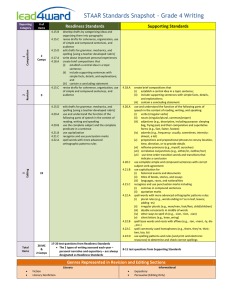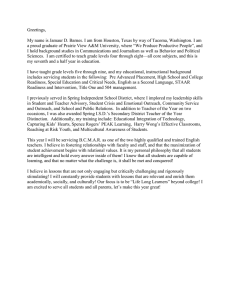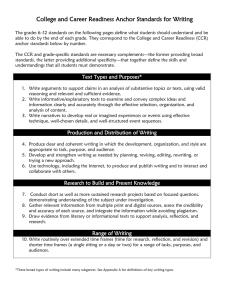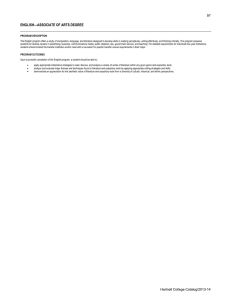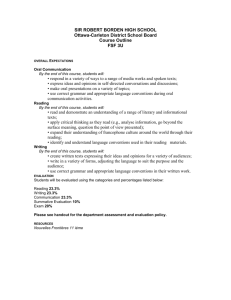Document 14657320
advertisement
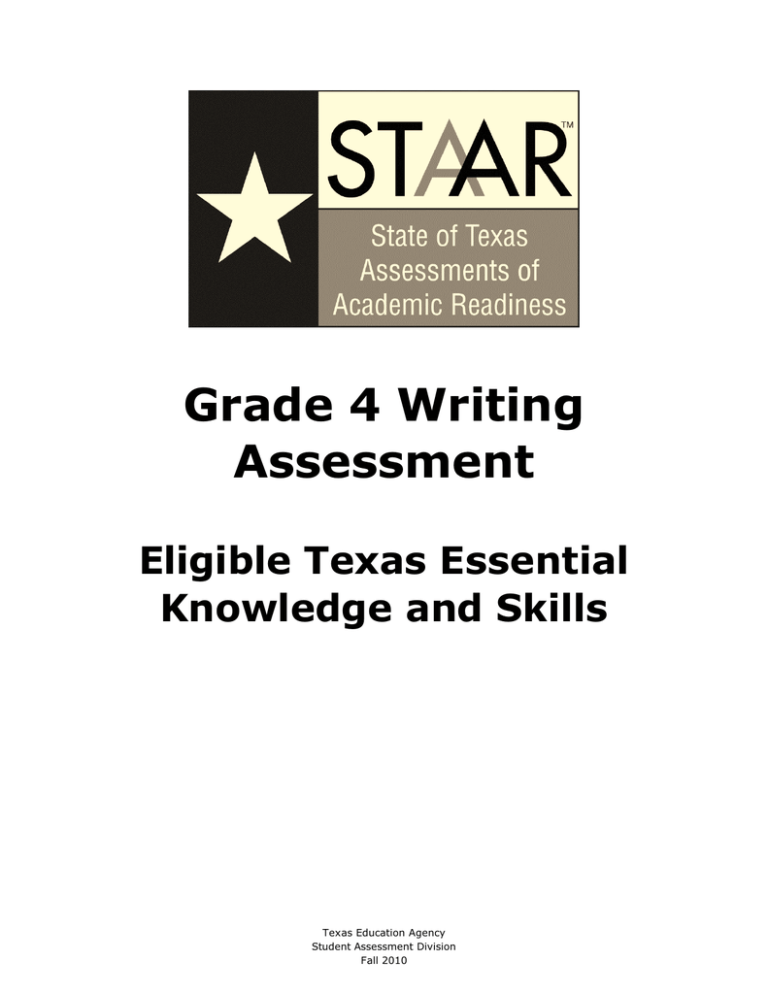
Grade 4 Writing Assessment Eligible Texas Essential Knowledge and Skills Texas Education Agency Student Assessment Division Fall 2010 STAAR Grade 4 Writing Assessment Reporting Category 1: Composition The student will demonstrate an ability to compose a variety of written texts with a clear, central idea; coherent organization; sufficient development; and effective use of language and conventions. (15) Writing/Writing Process. Students use elements of the writing process (planning, drafting, revising, editing, and publishing) to compose text. Students are expected to (B) develop drafts by categorizing ideas and organizing them into paragraphs; Readiness Standard (C) revise drafts for coherence, organization, use of simple and compound sentences, and audience; Readiness Standard (D) edit drafts for grammar, mechanics, and spelling [using a teacher-developed rubric]. Readiness Standard (17) Writing. Students write about their own experiences. Students are expected to (A) write about important personal experiences. Readiness Standard (18) Writing/Expository [and Procedural] Texts. Students write expository [and procedural or work-related] texts to communicate ideas and information to specific audiences for specific purposes. Students are expected to (A) c reate brief compositions Readiness Standard that (i) establish a central idea in a topic sentence; (ii) include supporting sentences with simple facts, details, and explanations; and (iii) contain a concluding statement. STAAR Grade 4 Writing Page 2 of 6 Texas Education Agency Student Assessment Division Fall 2010 Genres Represented in the Revision and Editing Sections of the Test: Literary • Fiction • Literary Nonfiction Informational • Expository • Persuasive (Editing only) Reporting Category 2: Revision The student will demonstrate an ability to revise a variety of written texts. (15) Writing/Writing Process. Students use elements of the writing process (planning, drafting, revising, editing, and publishing) to compose text. Students are expected to (C) revise drafts for coherence, organization, use of simple and compound sentences, and audience. Readiness Standard (18) Writing/Expository [and Procedural] Texts. Students write expository [and procedural or work-related] texts to communicate ideas and information to specific audiences for specific purposes. Students are expected to (A) create brief compositions that (i) establish a central idea in a topic sentence; Supporting Standard (ii) include supporting sentences with simple facts, details, and explanations; Supporting Standard (iii) contain a concluding statement. Supporting Standard STAAR Grade 4 Writing Page 3 of 6 Texas Education Agency Student Assessment Division Fall 2010 Reporting Category 3: Editing The student will demonstrate an ability to edit a variety of texts. (15) Writing/Writing Process. Students use elements of the writing process (planning, drafting, revising, editing, and publishing) to compose text. Students are expected to (D) edit drafts for grammar, mechanics, and spelling [using a teacher-developed rubric]. Readiness Standard (20) [Oral and] Written Conventions/Conventions. Students understand the function of and use the conventions of academic language when speaking and writing. Students continue to apply earlier standards with greater complexity. Students are expected to (A) use and understand the function of the following parts of speech in the context of reading, writing, and speaking: Readiness Standard (i) verbs (irregular verbs); Supporting Standard (ii) nouns (singular/plural, common/proper); Supporting Standard (iii) adjectives (e.g., descriptive, including purpose: sleeping bag, frying pan) and their comparative and superlative forms (e.g., fast, faster, fastest); Supporting Standard (iv) adverbs (e.g., frequency: usually, sometimes; intensity: almost, a lot); Supporting Standard (v) prepositions and prepositional phrases to convey location, time, direction, or to provide details; Supporting Standard (vi) reflexive pronouns (e.g., myself, ourselves); Supporting Standard (vii) correlative conjunctions (e.g., either/or, neither/nor); Supporting Standard (viii) use time-order transition words and transitions that indicate a conclusion; Supporting Standard (B) use the complete subject and the complete predicate in a sentence; Readiness Standard (C) use complete simple and compound sentences with correct subject-verb agreement. Supporting Standard STAAR Grade 4 Writing Page 4 of 6 Texas Education Agency Student Assessment Division Fall 2010 (21) [Oral and] Written Conventions/Handwriting, Capitalization, and Punctuation. Students write legibly and use appropriate capitalization and punctuation conventions in their compositions. Students are expected to (B) use capitalization Readiness Standard for (i) (ii) historical events and documents; Supporting Standard titles of books, stories, and essays; Supporting Standard (iii) languages, races, and nationalities; Supporting Standard (C) recognize and use punctuation marks Readiness Standard including (i) commas in compound sentences; Supporting Standard (ii) quotation marks. Supporting Standard (22) [Oral and] Written Conventions/Spelling. Students spell correctly. Students are expected to (A) spell words with more advanced orthographic patterns rules: Readiness Standard (i) plural rules (e.g., words ending in f as in leaf, leaves; adding -es); Supporting Standard (ii) irregular plurals (e.g., man/men, foot/feet, child/children); Supporting Standard (iii) double consonants in middle of words; Supporting Standard (iv) other ways to spell sh (e.g., -sion, -tion, -cian); Supporting Standard (v) silent letters (e.g., knee, wring); Supporting Standard (B) spell base words and roots with affixes (e.g., -ion, -ment, -ly, dis-, pre-); Supporting Standard (C) spell commonly used homophones (e.g., there, they’re, their; two, too, to); Supporting Standard STAAR Grade 4 Writing Page 5 of 6 Texas Education Agency Student Assessment Division Fall 2010 (D) use spelling patterns and rules [and print and electronic resources] to determine and check correct spellings. Supporting Standard STAAR Grade 4 Writing Page 6 of 6 Texas Education Agency Student Assessment Division Fall 2010

